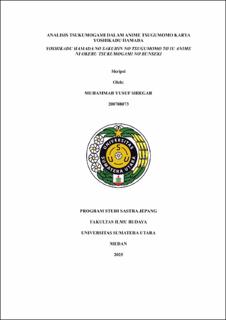Analisis Tsukumogami Dalam Anime Tsugumomo Karya Yoshikadu Hamada
Analysis of Tsukumogami in the Anime Tsugumomo by Yoshikadu Hamada

Date
2025Author
Siregar, Muhammad Yusuf
Advisor(s)
Arfianty, Rani
Alimansyar
Metadata
Show full item recordAbstract
This research focuses on Tsukumogami in the anime Tsugumomo by Yoshikadu Hamada. The purpose of this study is to identify the various forms of Tsukumogami and to understand their roles in the anime Tsugumomo. The term Tsukumogami consists of two parts: "tsukumo," which means "old" or "aged," and "kami," which means "spirit" or "god." Tsukumogami are youkai creatures in Japanese culture that originate from inanimate objects, especially tools that have aged one hundred years. The theories used in this study include Myth Theory, Form Theory, Literary Sociology Theory, and Role Theory. This research employs a qualitative method with a descriptive approach. Data were collected by listening to dialogues, watching the anime, and analyzing the Tsukumogami appearing in Tsugumomo. The results of the study show several forms and various roles of Tsukumogami in the anime. There are six objects that transform into spiritual beings called Tsukumogami. These objects are: obi (kimono sash), hair, books, masks, sketchbooks, and swords. Each has a different form, distinct characteristics, and unique powers. Furthermore, the roles of each Tsukumogami in the anime are as follows: the obi protects and defeats amasogi; hair disturbs the school environment and attacks humans; books attack humans; masks connect powers through noh masks and protect areas from curses; sketchbooks bring drawings to life and disturb humans; and swords protect their owners and cleanse curses.
Collections
- Undergraduate Theses [585]
